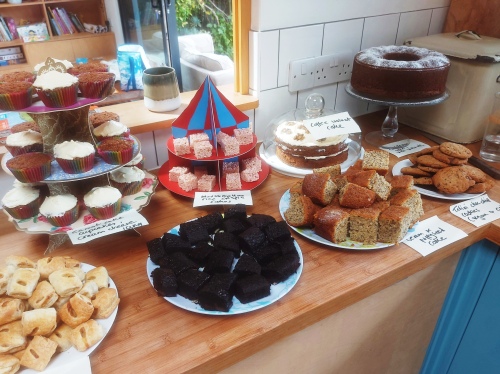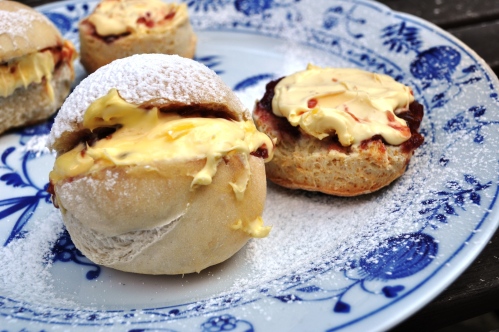After two years living in Italy, I was really surprised visiting New Zealand last year to see how ubiquitous the “gluten free” thing has become. Loads of cafés and bakeries had signs front and centre offering baked goods free of the perceived evils of gluten. It surprised me even more to see this has become commonplace in the UK too.
Although Eataly, the Slow Food-ish bourgeois supermarket in Rome, has a section of foods suitable for coeliac sufferers, generally I didn’t notice signs offering foodstuffs “senza glutine” in Italy. Sure they have bad baked products there in Italy, including crappy industrial white sliced (“pancarré”), but by and large there are still a lot more real bakeries selling real bread. The same thing that’s sustained humanity for centuries, and been the staff of life* for millennia.
What we’re experiencing is one of many battles being fought in today’s information wars, where lobbyists and their allied scientists, pseudo-scientists, semi-scientists and writers duke it out. Some represents the arable industry, or the (industrial) baked goods sector, others representing sections of the food industry, or sections of the media and publishing trade that are advocating a certain fad diet (low carb, carb-free, “paleo”, etc).
Every week, it seems, there’s another article in the media about the latest foodstuff that can satisfy dietary needs in lieu of wheat – quinoa, amaranth, buckwheat, coconut flour, almond meal, flax seed meal, buckwheat, chia and teff. Despite the fact that human civilisation, in Eurasia at least, was largely built on the nutritional strengths of grains – first domesticated as far back as 10,000BCE, possibly earlier, in the Fertile Crescent.
One of the big guns in the recent anti-wheat lobby is American cardiologist William R Davis, who published a book called Wheat Belly: Lose the Wheat, Lose the Weight, and Find Your Path Back to Health in 2011.
I’d seen the guy’s spiel on CBS and was partially drawn in – he said that modern wheat strains were so over-engineered that the crop had become toxic. It resounded with me due to my interests in older wheat varieties and in real bread made with them. His theory, however, was controversial.
A few days ago, Jeremy Cherfas, a fellow baker and a science and food communicator, posted a link to an article published in The Journal of Cereal Science in September 2013, with the catchy title ‘Does wheat make us fat and sick?’ While it’s not a scientific research piece in itself, it references and quotes a broad selection of studies to refute Davis’s theories.
It makes quite interesting reading. Though it also uses some language I struggled with, like “immunogenic epitopes”. So, I started writing this with the intention of succinctly summarising it. I’ve failed miserably on that front.
A few key points of refutation
Davis said modern bread wheat was “created by genetic research in the 60s and 70s” resulting in an “unnatural protein in our ‘modern wheat’ called gliadin”.
Apparently, commercially available wheat is still not GM, unless you consider millennia of selective breeding to be genetic modification.
Gliadin, meanwhile, is one of the two proteins that makes up gluten (the other is glutenin) and is present in all wheats and related species.
The article even picks on some specific pronouncements by Davis, such as “‘The proliferation of wheat products parallels the increase in waist size.'” The article’s response even manages to be almost humorous: “This statement implies that a correlation between two variables can be interpreted as a true causal relationship. It is certainly true that the increase in wheat sales has a parallel with an increase in obesity. However, there are also parallel increases in the sales of cars, mobile phones, sports shoes and the average speed of winners of the Tour de France.” Haha. Oh.
The article refutes the notion that wheat is a worse starchy food in GI terms sayaing, “However, the blood glucose response after bread consumption was lower than the response after eating the same amount of potatoes or white rice…”
It refutes Davis’s assertion that wheat can be addictive and cause withdrawal, by pointing out that although the body can create an opiate-like substance from “incomplete digestion of gliadin”, that substance simply cannot be absorbed by the gut and as such cannot get into the bloodstream or affect the nervous system.
Conversely, the article points out something that’s generally accepted among sane people: “the consumption of whole grain and whole grain fibre significantly improves blood glucose control, improves cholesterol levels, reduces blood pressure […etc]”.
So bread is still good, but only when it’s real bread made with wholegrain flour as responses are very different with “refined (white flour based) wheat bread”, which is a mealy-mouthed way of referring to that central culprit in ruining the reputation of bread as a healthy food: white sliced, the bastard child of post-war research in Chorleywood in the UK.
The article continues, “The authors conclude that the evidence regarding the relevance of refined grain and whole-grain product intake for the risk of obesity is judged as insufficient.”
Furthermore, they say, “studies show a possible relationship between whole-grain product intake and a reduced risk of obesity, a probable relationship with a lower risk of diabetes and coronary heart disease, and a convincing relationship with a reduced level of LDL cholesterol.”
The article also refers to further studies that “concluded that the intake of dietary fibre from cereals and other whole grains is associated with a reduced risk of colorectal cancer.”
The article does talk about the exceptions to these endorsements of the health benefits of wholegrain products, notably those who suffer from coeliac disease and wheat allergies, but it lost me a bit here and also disappointed in that in failed to discuss the related issue of the importance of fermentation in the production of bread, and how the biggest problem with the CWB white sliced is how it basically fails to properly ferment the dough.
An academic study done in Italy a few years ago indicated even coeliacs could digest bread if it was made properly – that is, with long fermentation. But presumably the authors of this study cannot come out straight and criticise such an important industrial food product, they just have to stick to criticising the theories of the faddish Wheat Belly.
Again, being somewhat mealy-mouthed the article said, “Wheat-containing foods prepared in customary ways and eaten in recommended amounts have been associated with numerous health benefits.” But “customary”, like “traditional”, is one of those words that’s open to interpretation. I mean, white sliced junk has been made in factories (factories – not bakeries) for more than 50 years. Does that make it a “customary way” of preparation? How long does something have to be done in a certain way to qualify as “customary”?
Conclusions
The article concludes “Arguments that the currently consumed wheat has been genetically modified resulting in adverse effects on body weight and illnesses cannot be substantiated. In particular, populations in some countries have obtained the major part of their daily energy intake from wheat-based foods for many years, such as Turkey, without reporting any detrimental effects on body weight or chronic disease.”
So ultimately the article is saying it’s nonsense that bread is fattening or intrinsically illness-inducing (for those not genetically predisposed), saying “There is no evidence that selective breeding has resulted in detrimental effects on the nutritional properties or health benefits of the wheat.”
The article doesn’t say it but I will: what’s fattening or bad for you is eating too much crap food – such as industrial white refined wheat products full of additives – and having a lazy, inert lifestyle that involves sitting on your arse too much.
You don’t need a gluten-free or faddish diet like “paleo” (nicely discussed here by Michael Pollan) to be healthy and have a suitable body mass. Just stop being a lazy sucker, get off your arse, walk or cycle to the shops, buy or make some properly fermented wholegrain real bread (ideally made with locally grown organic flour, to support your local and national economy and damage the environment less). It’s been good enough for thousands of generations of humanity – it’s good for you too.
Footnote
* Leviticus 26:26, King James Version (KJV): “And when I have broken the staff of your bread, ten women shall bake your bread in one oven, and they shall deliver you your bread again by weight: and ye shall eat, and not be satisfied.”





























